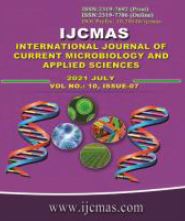


 National Academy of Agricultural Sciences (NAAS)
National Academy of Agricultural Sciences (NAAS)

|
PRINT ISSN : 2319-7692
Online ISSN : 2319-7706 Issues : 12 per year Publisher : Excellent Publishers Email : editorijcmas@gmail.com / submit@ijcmas.com Editor-in-chief: Dr.M.Prakash Index Copernicus ICV 2018: 95.39 NAAS RATING 2020: 5.38 |
Chronic suppurative otitis media (CSOM) is defined as chronic inflammation of the middle ear and mastoid cavity, which presents with recurrent ear discharges or otorrhoea through a tympanic perforation. The prevalence rate of CSOM in India is 7.8%. Inadequate antibiotic treatment, frequent upper respiratory tract infections with poor access to medical care are related to the development of CSOM.1 The bacteriological profile of CSOM keeps changing from place to place over the period of time, so this study was taken up to evaluate the scenario in our hospital. 120 clinically diagnosed cases of CSOM were studied for a period of 18 months in Dept of Microbiology, HIMS. History collected and swabs were collected aseptically. Identification of aerobic bacteria done as per standard operative procedures. Antibiotic susceptibility testing was done by Kirby-Bauer disc diffusion method. 98 cases yielded positive culture and 22 negative cultures. Bacterial isolates showed predominance of Staphylococcus aureus (34.23%) followed by Pseudomonas spp. (19.81%), Klebsiella spp. (14.41%) Proteus spp.(7.20%) Gram positive organisms were more sensitive to Linezolid, Vancomycin and Gram negative organism more sensitive to Colistin, Imipenem, and Amikacin.
 |
 |
 |
 |
 |